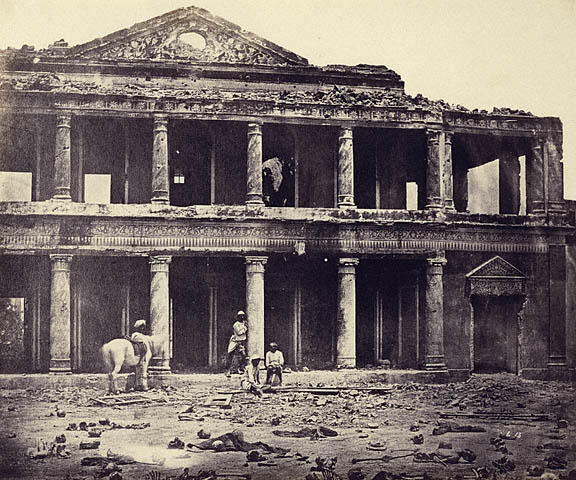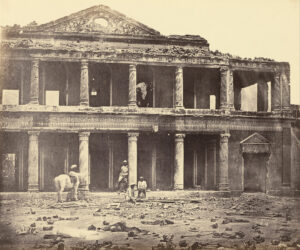
The Indian Mutiny
The ‘Indian Mutiny’, ‘Great Rebellion of 1857’, or the ‘First War of Indian Independence’ was a series of conflicts against British rule in India. It began as a mutiny of East India Company sepoys (soldiers) who were angered by the use of newly issued gunpowder cartridges that were rumoured to have been greased in pork and beef fat. Social tensions between the British and Indians were simmering in the years leading up to the mutiny. Christian proselytism stoked fears of British conversion of India’s non-Christian masses. The East India Company had also become much more brazen in their desire for territory, as was seen in the multiple wars of conquest after 1757.
The annexation of Awadh in 1856 was particularly galling as the north Indian state was an important military recruitment ground for the East India Company. Many of the sepoys from the region became resentful of the expansionist nature of the Company and the disregard it showed towards Indian sovereignty. Dissatisfaction also existed amongst the Indian peasantry who suffered under British mismanagement and exploitation under its land tax regime. These various grievances saw recently deposed Indian regional powers, Company sepoys, and various sections of Indian society coming out in rebellion against the British colonial presence.

Developments during the Mutiny and Rebellion
Bahrampore – the 19th Bengal Native Infantry on suspicion that cartridges had been greased with animal fat refused to use them and were subsequently dismissed. Saul David argues that many were disaffected due to the annexation of Oudh which demonstrated British belligerence and lack of compassion for native sensibilities.
Barrackpore – Mangal Pandey, popularly seen as the sepoy that initiated the mutiny, was acting on the rumours pervading the Bengal Native Infantry ranks. His call to rise up against the British points to opinion having already been formed amongst the sepoys. British officers mentioned an air of discontent and this was also demonstrated in sepoy-led arson attacks against those that had agreed to fire the new Enfield rifles. Mangal Pandey has since become an important symbol of anti-colonial national resistance.

Indian postage stamp commemorating the events of 1857. The popular nationalist narrative considers these events as ‘First War of Indian Independence’.
Source: Post of India, via Wikimedia Commons
Meerut – Sepoys refused to accept cartridges and 85 men were subsequently court martialled and jailed. On the following day, sepoys broke out in mutiny, freed prisoners, and British officers and civilians attacked. The mutineers then made their way to Delhi. The events in Meerut demonstrated a loss of faith in the British and a general mistrust of the British officer ranks amongst the sepoys. Meerut also saw the first occurrence of civilian unrest and indiscriminate killing of European civilians. Sepoys then converged on Delhi, the seat of the once great Mughal empire, a phenomenon that occurred in other parts of northern India.
Delhi – On the 11th May, arrival of sepoys caused unrest in the city with Europeans and Indian Christians the target of violence. Battalions of Bengal Native Infantry stationed close by also joined the rebellion. Europeans sought to congregate at the ‘Flagstaff Tower’ but on hearing that they would not be receiving military assistance headed for Karnal. On the 12th May, emperor Bahadur Shah accepted the sepoys’ allegiance. This brought the Mughal empire into the conflict. On 16th May 50 European prisoners were killed in the palace courtyard. The mutiny developed into a much greater conflict with the turn of events in Delhi. At this point it became clear that the mutineers were seeking a figurehead for a more substantial challenge to British authority.
Cawnpore – Discontent spread amongst sepoys in part due to a British officer being acquitted for shooting at his Indian guard whilst drunk. The sepoys mutinied and headed for Delhi however Nana Sahib, the former Peshwa (prime minister) of the Maratha Confederacy, convinced them to return to Cawnpore. Under considerable bombardment and loss of life, entrenched British forces surrendered under condition that they be given safe passage to Allahabad.
Whilst preparing to leave by boat sepoys fired and cut down British soldiers in and around the water of Satichaura Ghat. Surviving women and children were kept prisoner in Bibighar but were later hacked to death. In all, around 200 women and children were murdered. The massacre became infamous and retribution for events in Cawnpore motivated British forces. Cawnpore was the site of the major siege battle of the rebellion. A further development in the chronology of events is the involvement of the Marathas in the events of 1857. At Cawnpore, it was the disaffected Nana Sahib who led the mutineers in the siege battle. Nana Sahib’s involvement also highlighted the various grievances that compelled Indians to rebel against the British. In Nana Sahib’s case it was in part due to the British refusing to honour the pension that he was promised and also the tantalising prospect of re-establishing Maratha power on the Deccan.

Peshwa Nana Sahib of the Maratha Confederacy
Source: Charles Forjett, Public domain, via Wikimedia Commons
Lucknow – Rebellion against the British was led by Begum Hazrat Mahal the wife of the recently deposed Nawab of Oudh. British civilians converged on Lucknow as it was the capital city and the residence of the British governor of Oudh. Mutinous regiments from the surrounding area headed to Lucknow to confront the British. After a long siege, British reinforcements arrived from Cawnpore and repelled the mutinous sepoys. Lucknow was also witness to a similar siege battle to Cawnpore.
The leader of the mutineers in Lucknow had different ambitions to Nana Sahib. She wanted to re-establish an independent Oudh. The annexation of Oudh was particularly strongly felt amongst the sepoys because many were from this region. Their personal grievances in the service of the EIC along with the audacious annexation of state signalled the belligerence and insensitivity of British policy to those of the Bengal Native Infantry. Lucknow saw the British counter-offensive gaining momentum with British forces arriving from Cawnpore repelling and ultimately ending the siege at Lucknow.
Jhansi – Europeans were massacred in the recently annexed princely state of Jhansi. The Rani was unsure as to who to side with. Neighbouring princely states loyal to the British were showing territorial ambitions on Jhansi whilst her appeals to the British were met with a cold response. Sepoys demanded arrears of pay if she did not agree to fight the British. In these circumstances, she decided to fight against the British and made preparations for battle. However, British advances in Jhansi necessitated a flight of the Rani of Jhansi’s forces to Gwalior.
The events in Jhansi demonstrated the disjointed nature of the rebellion and the divergent interests of its various leaders. The Rani of Jhansi was primarily interested in protecting the sovereignty of her state from neighbouring powers. It can be argued that she was almost compelled to fight the British given the circumstances.

Rhani of Jhansi engaging British East India Company forces
Source: Unknown artist, Public domain, via Wikimedia Commons
Gwalior – Mutinous sepoys under Rao Sahib were joined by the Rani of Jhansi. Ultimately, the Rani was killed in battle. After the death of the symbolic figurehead of the late-stage resistance to the British counter-offensive, the rebellion was extinguished. Gwalior saw the coming together of Rao Sahib, a fellow Maratha and the Rani of Jhansi. This demonstrated that there was a certain level of Maratha solidarity and shared ambitions although this was undermined by other Maratha rulers who sided with the British.
Share this Article
Our Funders

